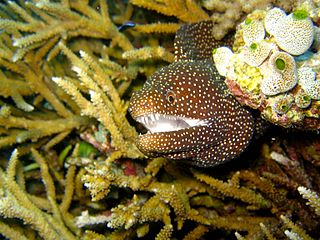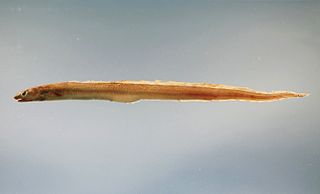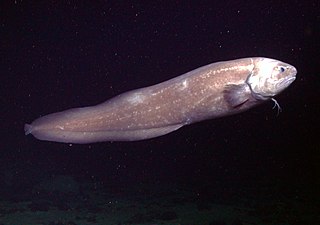
The jack snipe or jacksnipe is a small stocky wader. It is the smallest snipe, and the only member of the genus Lymnocryptes. Features such as its sternum make it quite distinct from other snipes or woodcocks.

Moray eels, or Muraenidae, are a family of eels whose members are found worldwide. There are approximately 200 species in 15 genera which are almost exclusively marine, but several species are regularly seen in brackish water, and a few are found in fresh water.

Conger is a genus of marine congrid eels. It includes some of the largest types of eels, ranging up to 2 m (6 ft) or more in length, in the case of the European conger. Large congers have often been observed by divers during the day in parts of the Mediterranean Sea, and both European and American congers are sometimes caught by fishermen along the European and North American Atlantic coasts.

Ophichthidae is a family of fish in the order Anguilliformes, commonly known as the snake eels. The term "Ophichthidae" comes from Greek ophis ("serpent") and ichthys ("fish"). Snake eels are also burrowing eels. They are named for their physical appearance, as they have long, cylindrical, snake-like bodies. This family is found worldwide in tropical to warm temperate waters. They inhabit a wide range of habitats, from coastal shallows and even rivers, to depths below 800 m (2,600 ft). Most species are bottom dwellers, hiding in mud or sand to capture their prey of crustaceans and small fish, but some are pelagic.

The slender snipe eel, also known as the deep sea duck, is a fish that can weigh only a few ounces, yet reach 5 feet or 1.5 m in length. Features include a bird-like beak with curving tips, covered with tiny hooked teeth, which they use to sweep through the water to catch shrimp and other crustaceans. It has a lifespan of ten years.

The superorder Elopomorpha contains a variety of types of fishes that range from typical silvery-colored species, such as the tarpons and ladyfishes of the Elopiformes and the bonefishes of the Albuliformes, to the long and slender, smooth-bodied eels of the Anguilliformes. The one characteristic uniting this group of fishes is they all have leptocephalus larvae, which are unique to the Elopomorpha. No other fishes have this type of larvae.

The cusk-eel family, Ophidiidae, is a group of marine bony fishes in the Ophidiiformes order. The scientific name is from the Greek ophis meaning "snake", and refers to their eel-like appearance. True eels diverged from other ray-finned fish during the Jurassic, while cusk-eels are part of the Percomorpha clade, along with tuna, perch, seahorses and others.

Snipe eels are a family, Nemichthyidae, of eels that consists of nine species in three genera. They are pelagic fishes, found in every ocean, mostly at depths of 300–600 m (980–1,970 ft) but sometimes as deep as 4,000 m (13,000 ft). Depending on the species, adults may reach 1–2 m (39–79 in) in length, yet they weigh only 80–400 g (2.8–14.1 oz). They are distinguished by their very slender jaws that separate toward the tips as the upper jaw curves upward. The jaws appear similar to the beak of the bird called the snipe. Snipe eels are oviparous, and the juveniles, called Leptocephali, do not resemble the adults but have oval, leaf-shaped and transparent bodies. Different species of snipe eel have different shapes, sizes and colors. The similarly named bobtail snipe eel is actually in a different family and represented by two species, the black Cyema atrum and the bright red Neocyema erythrosoma.
Cyema is a monospecific genus of marine ray-finned fish belonging to the monotypic family Cyematidae. The only species in the genus is Cyema atrum, the arrow eel, bobtail eel, bobtail snipe eel or deepwater eel. This species has circumglobal distribution.

Leptocephalus is a genus that was used for species of larval eels, called leptocephali, that were thought to be new fish species, or whose adult eel species were not known. Leptocephali differ so much in appearance from their adults that the larvae and adults of eels are not easily matched, and when first discovered, leptocephali were thought to be a distinct type of fishes, but not eels. Because of this, the genus designation of Leptocephalus was used for a while for unidentified leptocephali even after it was known that these were the larvae of eels thus becoming a "wastebasket taxon", but this practice is no longer used. Examples of marine congrid larvae, found in the western Indian Ocean and the Red Sea that were named this way are listed below. Only two species in two families are currently treated as having any validity, though the validity of L. bellottii is strongly in doubt.

Eels are ray-finned fish belonging to the order Anguilliformes, which consists of eight suborders, 20 families, 164 genera, and about 1000 species. Eels undergo considerable development from the early larval stage to the eventual adult stage and are usually predators.

Labichthys is a genus of eels in the snipe-eel family Nemichthyidae. It currently contains the following species:
Nemichthys is a genus of eels in the snipe-eel family Nemichthyidae. It currently contains the following species:

Protanguilla palau is a species of eel, the only species in the genus Protanguilla, which is in turn the only genus in its family, Protanguillidae. Its common name is Palauan primitive cave eel. Individuals were found swimming in March 2010 in a deep underwater cave in a fringing reef off the coast of Palau.
Avocettina acuticeps, the southern snipe eel or southern fintail snipe eel, is an eel in the family Nemichthyidae. It was described by Charles Tate Regan in 1916, originally under the genus Leptocephalus. It is a marine, deep water-dwelling eel which is known from throughout the southern regions of the ocean, with the exception of the eastern Pacific. It is known to dwell at a maximum depth of 2,000 metres (6,600 ft). Males can reach a maximum total length of 77 centimetres (30 in).
Avocettina bowersii is an eel in the family Nemichthyidae. It was described by Samuel Garman in 1899. It is a marine, deep water-dwelling eel which is known from California, U.S.A.; Peru, and Chile. It dwells at a depth range of 92–641 metres, although the type specimen was collected from a depth of 2,692 metres.
Avocettina paucipora is an eel in the family Nemichthyidae. It was described by Jørgen G. Nielsen and David G. Smith in 1978. It is a marine, temperate water-dwelling eel which is known from the southwestern Atlantic, southern Indian, and the Pacific Ocean. They can reach a maximum total length of 55 centimetres.
The Yano's snipe eel is an eel in the family Nemichthyidae. It was described by Giles Willis Mead and Ira Rubinoff in 1966, originally under the genus Avocettinops. It is a marine, deep water-dwelling eel which is known from New Zealand, in the southwestern Pacific Ocean.












